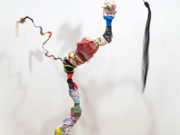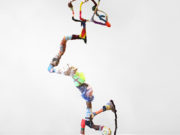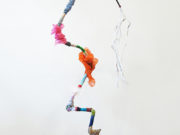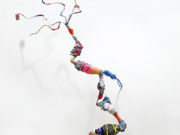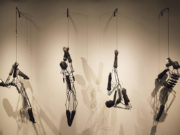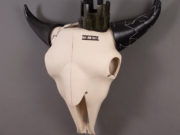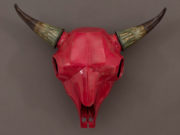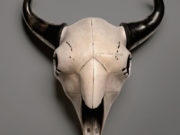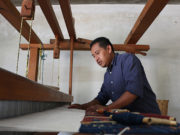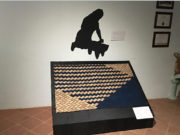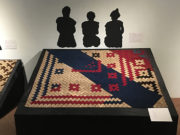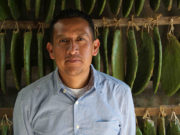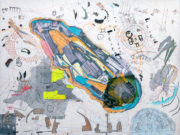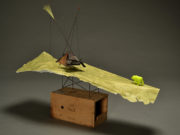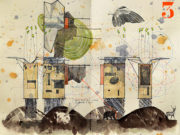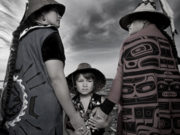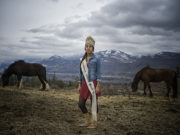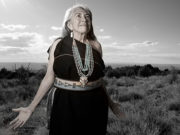Past exhibitions
Sept. 22, 2021 – “Songs & Stories From Lakota Country” by Frank Waln (Sicangu Lakota)
Digital artist talk and online performance with Sicangu Lakota performer, speaker and writer Frank Waln. As an Indigenous music producer and audio engineer, Frank fuses traditional Lakota instruments with hip-hop and electronic music to create songs that shed light on Indigenous history and decolonization. Titled “Songs & Stories From Lakota Country,” and moderated by Native hip-hop artist Paul Wenell Jr., this one-of-a-kind performance connects us all to our past, present and future as Frank explores connections of Indigenous history in the U.S. and issues currently affecting Native American communities and non-Native communities living on colonized Indigenous land. Rooted in the Lakota tradition of storytelling, Frank shares songs and stories about his upbringing and education on the Rosebud Indian Reservation in South Dakota and his experiences living in Chicago.
View recording of the artist talk:
“I’m looking forward to sharing music and the stories of my ancestors, my community, my resistance and our history,” Frank said. “This online performance will not only educate and raise awareness, it will radically change the way people view themselves and the land they live on, Native and non-Native alike.”
Frank is a Gates Millennium Scholar and earned a bachelor’s degree in audio arts and acoustics from Columbia College Chicago. Frank’s work has been recognized with many industry awards. He has received three Native American Music Awards, the 2014 NCAIED Native American 40 Under 40 Award and the Columbia College Chicago’s 2014 Mayor’s Award for Civic Engagement. He has written for numerous publications, including: The Guardian, School Library Journal and Indian Country Today. Frank was a contributing author to “American Like Me,” a New York Times Best Seller by America Ferrera. He is currently working on a new Native flute album.
Find more of his work on Instagram and Twitter at handle @FrankWaln and on his website at frankwaln.com.
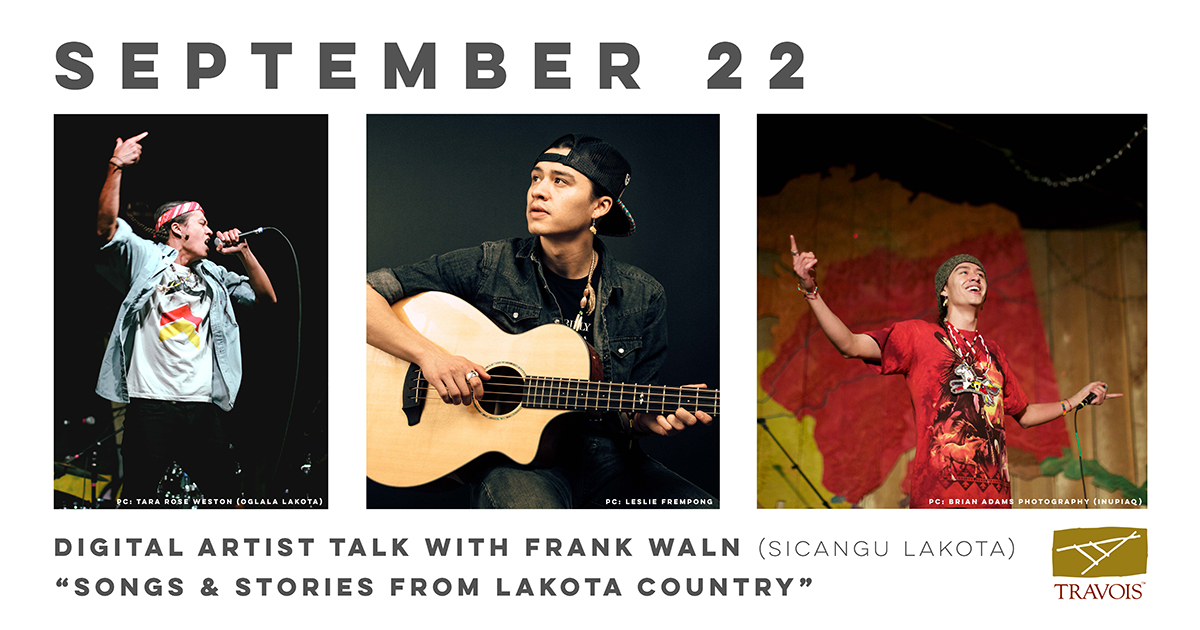
Nov. 6, 2020 – “The Great Basin Native Artists” by Melissa Melero-Moose (Northern Paiute, Modoc)
Melissa Melero-Moose, a Great Basin Native artist, discusses the origins and processes of her Great Basin mixed-media artwork. She also explains the evolution of her career, which led her to founding Great Basin Native Artists, a collective of Indigenous artists living in or from the region.
View recording of the artist talk:
“I created these works to celebrate the art, design and culture of the Paiute people through color and texture on canvas,” Melissa said. “I am honored to be a part of Travois First Fridays and very grateful to be sharing my paintings and stories in this part of the country.”
Melissa Melero-Moose is a Northern Paiute enrolled with the Fallon Paiute-Shoshone Tribe with ties to Fort Bidwell Paiute, Calif. She is an accomplished artist with her own unique style. Her works consist of contemporary mixed media paintings inspired by the landscape and culture of the Numu (Northern Paiute) in Nevada, California, and Oregon — natural surroundings in the Great Basin (willow and pine nuts), and Paiute basketry and local petroglyphs. Melissa has also integrated her own green painting techniques and disciplines to her process that ensures a lighter environmental footprint.
Melissa holds a BFA from the Institute of American Indian Arts and a bachelor’s degree in psychology and fine arts from Portland State University. Her works are included in permanent collections of the School for Advanced Research (IARC), Santa Fe, N.M.; Autry Museum in Los Angeles, Cali; Museum of Contemporary Native Arts in Santa Fe, N.M.; the Nevada State Museum in Carson City, Nev.; and the Lilley Museum, at the University of Nevada, Reno.
Visit melissamelero.com for additional artist info. And find more info on the Great Basin Native Artists here: greatbasinnativeartists.com.
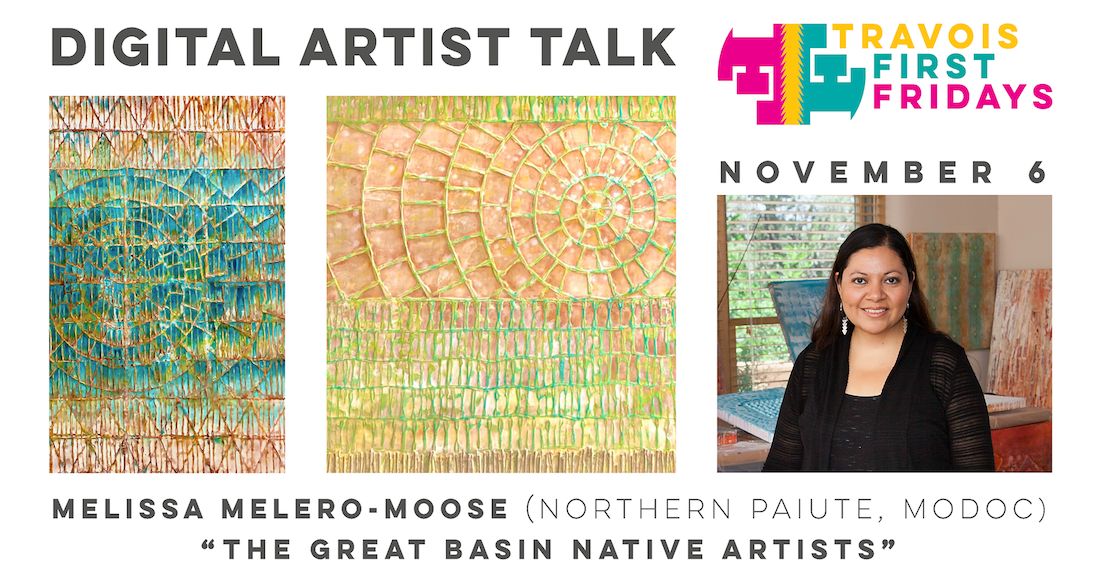
Oct. 2, 2020 – “Disappearing Earth/Invisible Sky” by Starr Hardridge (Muscogee Creek Nation)
Digital artist talk with artist Starr Hardridge – a discussion about southeastern contemporary Native pointillism in the time of a pandemic. Starr Hardridge is an enrolled member of the Muscogee Creek Nation. His works are an assemblage of pointillism and a Southeastern Woodlands beadwork aesthetic. Starr uses bold colors and geometric shapes to create modern works inspired by Muscogee patterns and designs. Through pattern, texture, and dream-like reverie, his work is a sensory journey of candy-coated hues and meticulously executed textures. Even serious contemplative themes are handled with a delicate mix of reverence and whimsy.
View recording of the artist talk:
“I draw inspiration from all things in nature and I try to make connections from the past to the present with an assemblage of multicolor paint dots,” Starr said. “I use pointillism as a means to express a “beaded surface” in which I narrate relationships and archetypes of the human condition.”
Starr received a BFA in illustration and painting from Savannah College of Art and Design. He continued his studies at a one-year residency in Penne D’Agenais France at the Nadai Verdon Atelier of Decorative Arts.
Visit starrhardridge.com for more artist information.
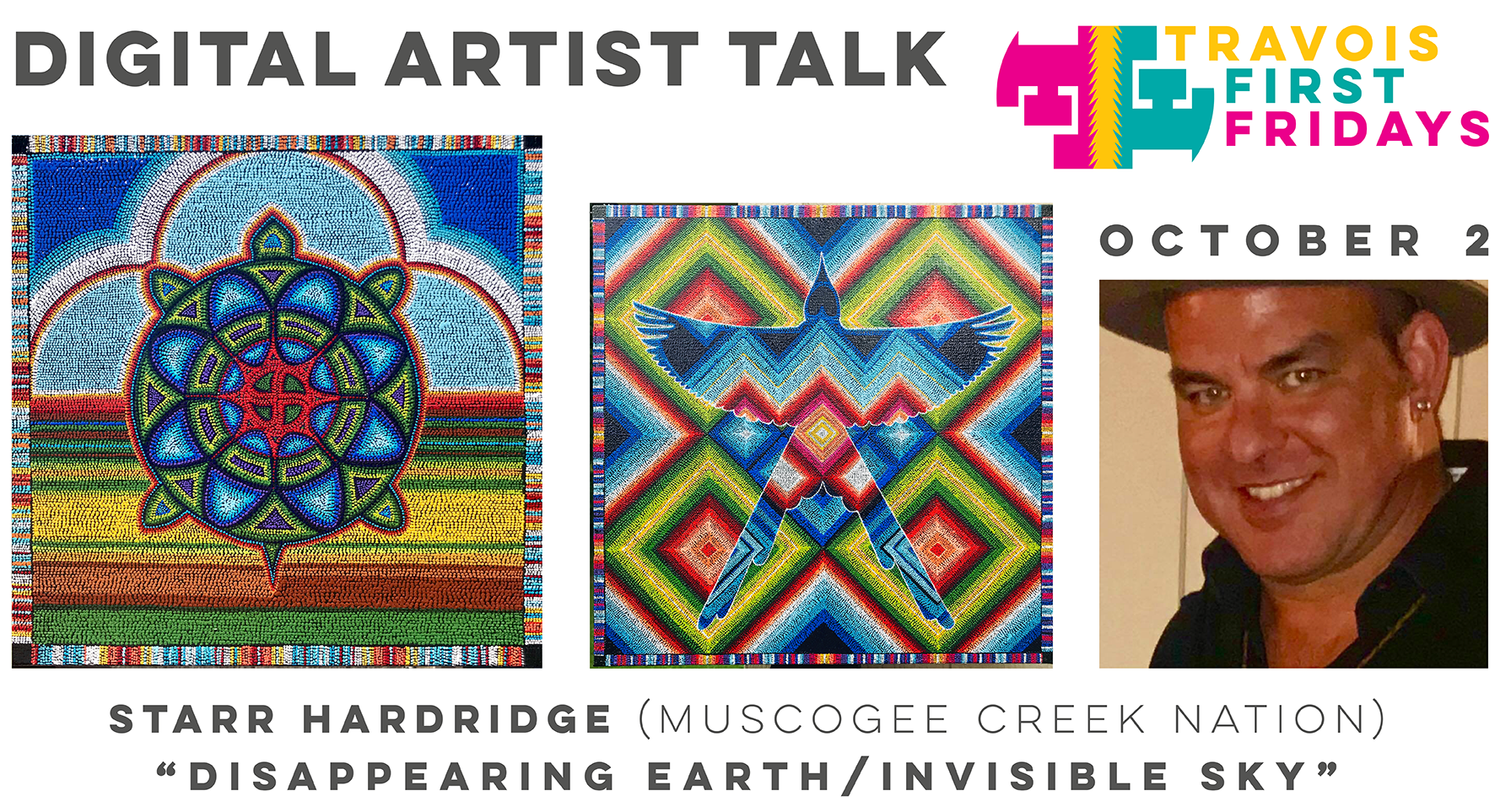
Sept. 4, 2020 – “The Current State” by Thomas Breeze Marcus (Tohono O’odham Nation)
Digital artist talk with artist Thomas “Breeze” Marcus as he broadcasts from the Arizona Heritage Center. Breeze will showcase an ongoing and eye-opening art series created to foster a dialog about the border wall, desecration of sacred sites, and how the U.S.-Mexico border militarization is affecting a southern Arizona Native American community, the Tohono O’odham Nation. Breeze will also discuss his canvas and large-scale mural work, process and the inspiration behind his art. He will present pieces from an exhibition currently showing in Phoenix and other pieces on canvas that talk to the duality of everyday issues among the Tohono and Akimel O’odham tribes of Arizona.
View recording of the artist talk:
Thomas Breeze Marcus, commonly referred to as “Breeze,” is a full-time artist based in Phoenix. He is a painter with over two decades of large scale mural and public art experience. His personal work showcases a tightly interwoven and complex composition of patterns. Breeze developed the line work out of his experience as a graffiti writer and inspiration from his native cultures — most notable, the intricate woven basket patterns and cultures of the Tohono O’odham and Akimel O’odham Tribes.
Breeze pushes the boundaries with his compositions. He moves in a forward direction but maintains awareness of the surrounding environment, personal identity and experience, human behavior, social issues and all things beyond the human view.
Breeze is also an arts educator working with youth in the Salt River community, and has performed multiple artist presentations, projects and workshops on murals, street art and graffiti at museums such as the Heard Museum in Phoenix, Ariz.; the Field Museum of Chicago, Ill.; and several other institutions throughout the country.
Find more of Breeze’s work on Instagram @breeze1phx.
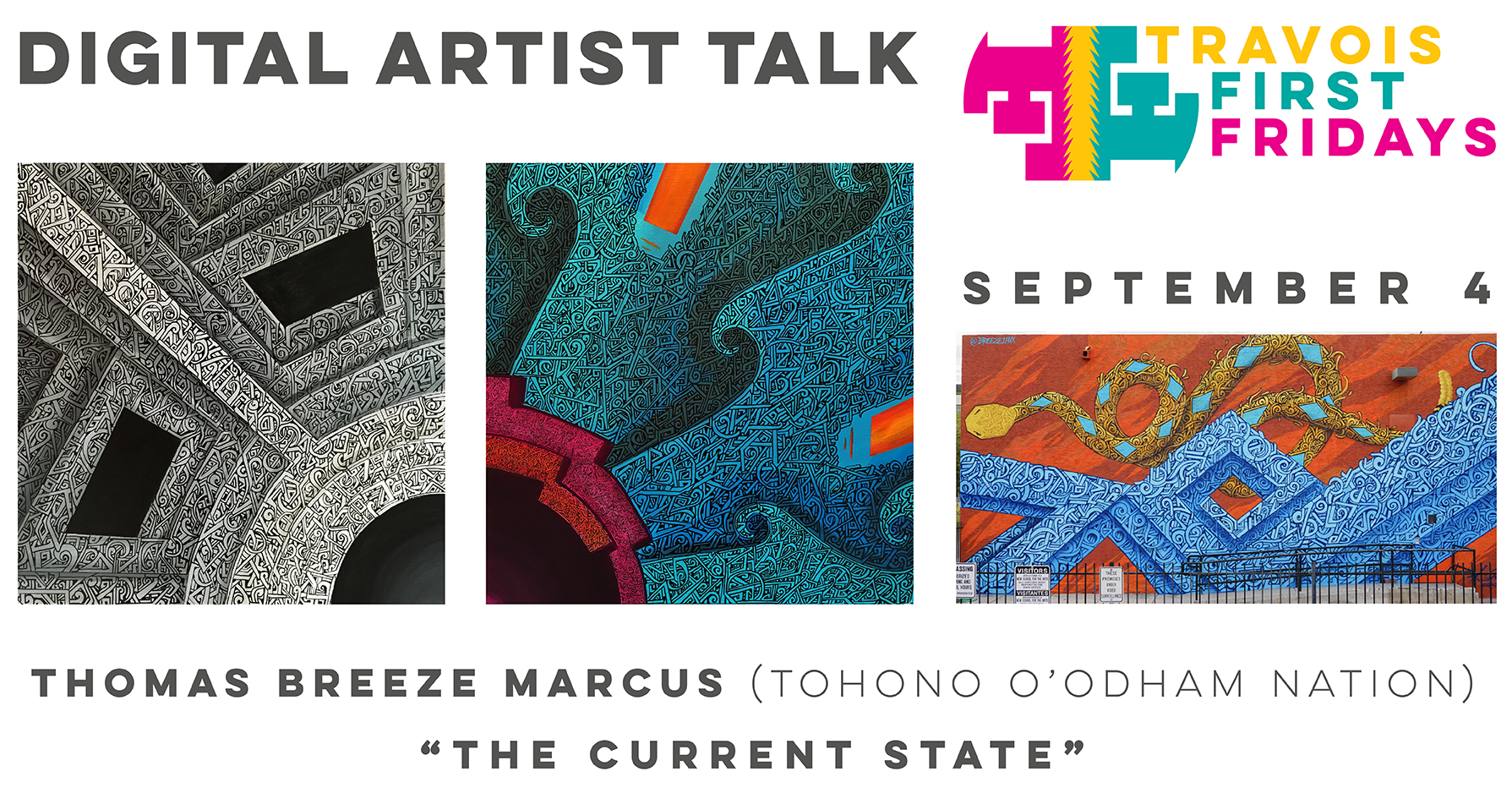
Nov. 1, 2019 – “Playing with Fire” by Yatika Starr Fields (Osage, Cherokee & Creek)
In his artist statement, Yatika Starr Fields said: “I am motivated in my work fundamentally by the search for freedom in all forms. I seek to create a contemporary terrain in the juxtaposition of my living memories. Dissolving elements of space and time, I create a synthesis of symbolic forms and objects floating and bending on the canvas at all angles, negating the horizon and the rule of linear experience. The objects and forms represent the past and present from my perspective as a member of the Osage, Cherokee and Creek Nations of Oklahoma surrounded by beautiful colors and patterns joined by rhythm and dance from tradition. Fast paced cities and humble highways of the plains are defined by a historical layering of cultures, art and creativity that I seek to portray. In the essence of painting, my process has journeyed from abstract to most recently focusing on representational, landscapes and figurative. By removing what the eye perceives and knows and leaving what the body feels with hints of dialogue revealing truths and questions — sensation through color and movement — tied together with cultural affinity but provoked by general concerns of world differences. The creation mythology of this space is narrated in my work from inspirations of culture, travels abroad and life in Boston, New York City, the Pacific Northwest and now back in the state I was born, Oklahoma. Resulting in an explosion of current experience, in this suspended trichotomy between nature, urban experiences and traditions, a new world is made.”
His work is included in the collections of the Heard Museum, Peabody Essex Museum, Oklahoma State Museum of Art and Sam Noble Museum. He was a Tulsa Artist Fellowship recipient in 2017.
Learn more about his work on Instagram @yatikafields and on Twitter @Yatikafields.
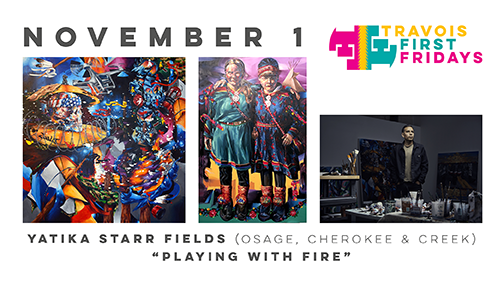
Oct. 4, 2019 – “Generational Knowledge” by Mona Cliff (Aaniiih / Tribe of Fr. Belknap, Montana)
Mona Cliff was born in Prescott, AZ, was raised in Portland, OR, and currently resides in Lawrence, KS. She is an enrolled member of the Aaniiih (White Clay people)/ Assiniboine tribes, and has Polish and German heritage. She uses traditional Indigenous techniques in conjunction with contemporary images.
Cliff explores the subject of identity, culture and mixed heritage. She earned a Bachelor of Fine Arts in Printmaking at Cornish College of the Arts in Seattle, WA. During that time, she used photo-etching and collage to explore issues of Native identity in contemporary America, by using humor to address stereotypical ideas of Native people and identity. After graduating, she turned to traditional Native methods as a way of further understanding the connection of Indigenous identity.
“In this series ‘Generational Knowledge,’ I am creating a space to honor what has been labeled ‘woman’s work.’ I am looking toward the mediums and conduits of craft, how Indigenous cultures thrive and are created in the quiet corners of a home,” Cliff said. “My art is rooted in my Aaniiih and Eastern European heritage. I use my art to explore the concept of woman as gatekeepers of cultural knowledge, how this knowledge forms personal identity, and is passed down generationally to create traditions.”
Learn more on Instagram @SpottedCloud and on Twitter @Spotted_cloud.
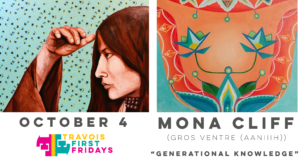
Sept. 6, 2019 – “Kanza Shokhi (Homecoming): The Art of Chris Pappan”
Chris Pappan is an American Indian artist of Osage, Kaw, Cheyenne River Sioux, and mixed European heritage. His art reflects the dominant culture’s distorted perceptions of Native peoples while proclaiming that “We are still here!” A graduate of the Institute of American Indian Arts in Santa Fe and a nationally recognized painter, Pappan calls his art “Native American Low Brow.”
He exhibits in several Native American art shows and markets nationally including the Santa Fe Indian Market, the Heard Indian Fair and Market, and the Eiteljorg. He currently resides in Chicago with his wife, Debra Yepa-Pappan, and their daughter.
“I am a Kanza artist; the state of Kansas derives its name from our people. Shokhi is a Kanza word that means ‘return to one’s home’ or ‘homecoming,’” Pappan said. “I am returning to the homelands of my people through my artwork and always strive to honor my ancestors. Within the genre of ledger art, I attempt to convey recognition of our culture while infusing pop art and lowbrow influences, so people may understand us in a modern context.”
Learn more on his website at chrispappan.com and on Instagram @chrispappan.
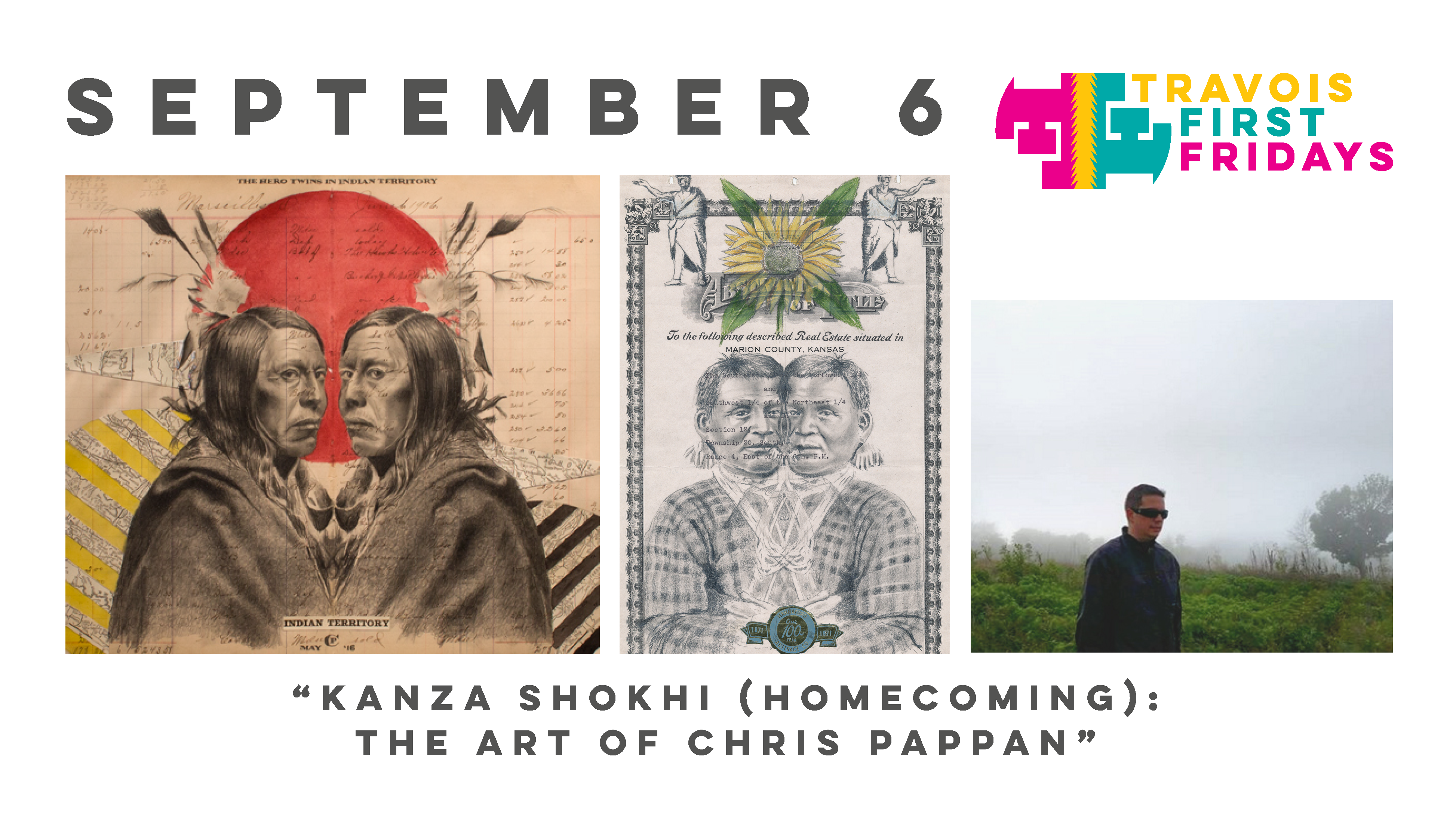
June 7, 2019 – “Wounds Many” by Keith Secola (Northern Ute and Anishinaabe nations)
Keith Secola grew up in the Southwest and earned an MFA from California College of the Arts in San Francisco, focusing on silkscreen printing, and currently lives and works in Oakland, CA. He received a BFA from the Institute of American Indian Arts in 2012.
Finding a balance between contemporary life and tradition, Secola creates a blend of images, prints, paintings, and installation derived from oral storytelling and Native America to communicate his work. Most recently, he was named a 2018-2019 Fellowship Artist by the Kala Art Institute in Berkeley, CA.
Learn more on his website at www.keithsecolajr.com and on Instagram @Mino_mashkiki.
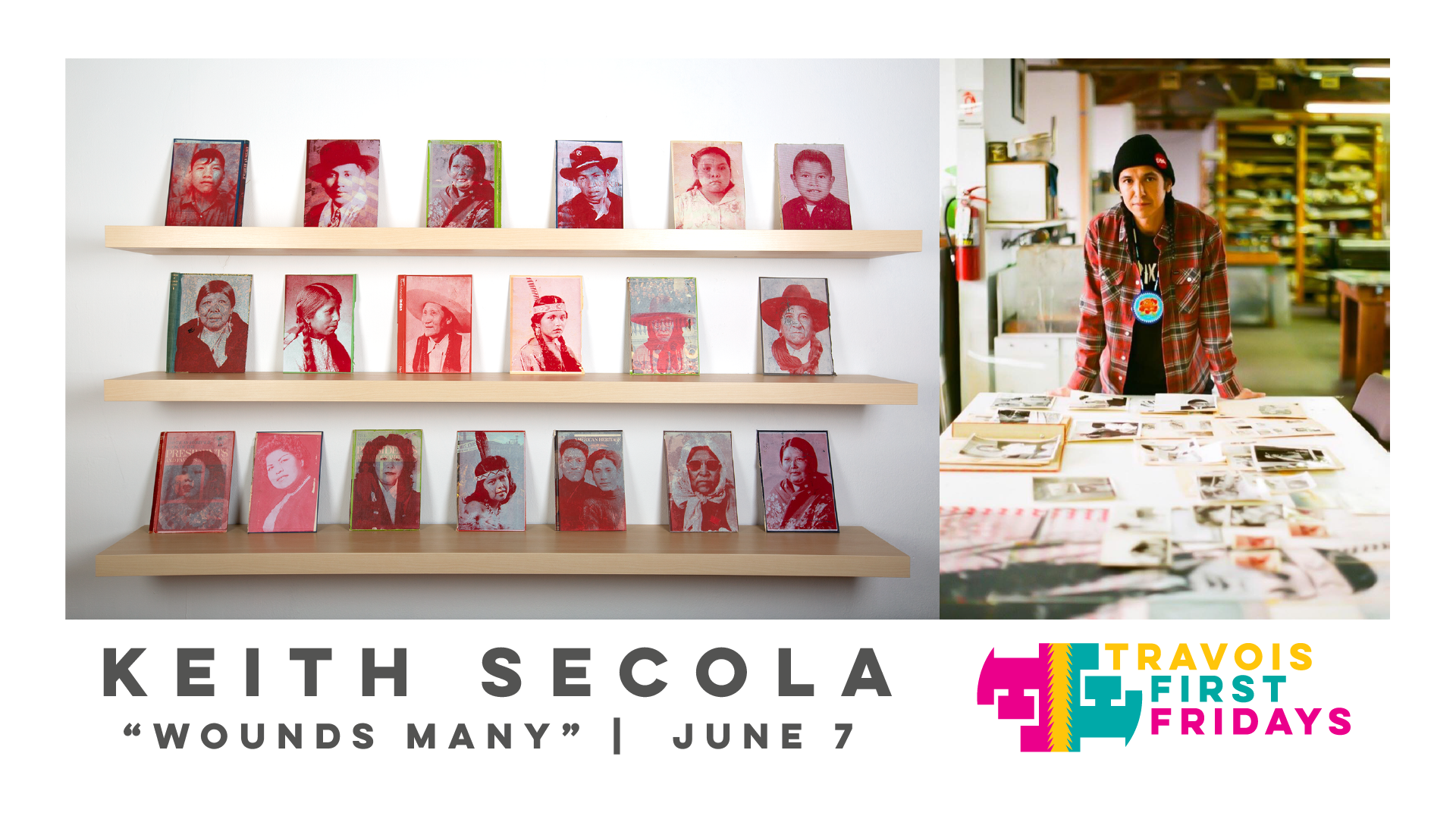
March 1, 2019 – “Below The Surface” by Holly Wilson (Delaware Nation/Cherokee)
Contemporary multi-media artist Holly Wilson (Delaware Nation/Cherokee) has been exhibiting her intimate bronzes, photography, and encaustic relief paintings nationally and internationally since the early 1990s. Her figures serve as her storytellers to the world, conveying stories of the sacred and the precious, capturing moments of our day, our vulnerabilities and our strengths. The stories are at one time both representations of family history as well as personal experiences. Holly’s work reaches a broad audience allowing the viewer the opportunity to see their personal connection. She works in a variety of media including bronzes, encaustic, photography, glass and clay.
For Travois First Fridays, the exhibition featured photography and sculptures. Read more about Holly on her website.
Related articles:
Travois First Fridays: “Below the Surface” by Holly Wilson
Travois First Fridays: What we’ve seen and what’s ahead
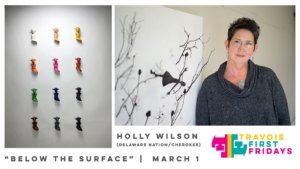
Dec. 7, 2018 – “ME” by Nelda Schrupp (Pheasant Rump Nakota First Nation)
Nelda Schrupp was born the youngest of 11 children, to Cecilia and Henry McArthur, and grew up on White Bear Indian Reservation, Carlyle, Saskatchewan. She attended various boarding schools and earned her BFA degree from the University of North Dakota in 1990. She majored in art with a concentration in ceramics and a minor in jewelry and small sculpture. This exposure to metalwork enticed her to study this medium in more detail. She entered graduate school in 1993 at the University of North Dakota and received an MFA degree in metalsmithing, jewelry and small sculpture.
In her artist statement, Schrupp said, “From a young age, I have been interested in sewing, beading, and working with my hands. When I would come back from boarding school, my mother would teach me her techniques of sewing (where I started on an old pedal Sears sewing machine), or hand stitch cloth and leather. My mother would have me work on small projects, patching clothes, and as I became more proficient, I would help sew dance regalia. I have always been interested in working with my hands. Her teachings have been very instrumental in my ability to clothe my family in hard times. I have beaded on a loom and directly on to regalia. I have been called upon numerous times to teach moccasin-making, willow-weaving and bead-working.”
For Travois First Fridays, her exhibition featured 10 artworks, including wall hangings and jewelry. Learn more on her website, Facebook, Twitter and LinkedIn.
Related articles:
Travois First Fridays: “ME” by Nelda Schrupp
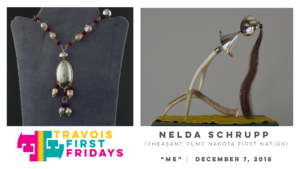
Nov. 2, 2018 – “Kéyah (Land)” by Dakota Mace, Diné (Navajo)
Dakota Mace is a Diné (Navajo) artist from Albuquerque, NM. She received her MFA and MA from the University of Wisconsin-Madison in Madison, WI and her BFA from the Institute of American Indian Arts in Santa Fe, NM. She is pursuing a second MFA in Textile Design in the School of Human Ecology at the University of Wisconsin-Madison in Madison, WI.
Her work focuses on translating the language of Diné weaving history as well as beliefs through different mediums and techniques. This serves as not only a different approach to cultural reclamation and preservation but also the importance of the meanings of the motifs used in her work. Mace feels that in order to understand a culture you must do so through design in order to understand the relationship to land and self.
For Travois First Fridays, her exhibition featured 15 of her works. Learn more on her website, Instagram, Flickr and 500px.
Related articles:
Travois First Fridays: “Kéyah (Land)” by Dakota Mace
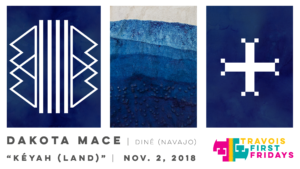
Oct. 5, 2018 – “Remedy/Reconcile/Rebuild” by Luanne Redeye (Seneca Nation of Indians and Hawk Clan)
Born in Jamestown, N.Y., Luanne Redeye grew up on the Allegany Indian Reservation in Western New York. In her artist statement, Redeye said this is where she draws inspiration incorporating community and family members into her paintings, giving her works a strong personal and emotional component. Redeye currently lives in Albuquerque, N.M. An enrolled member of the Seneca Nation of Indians and Hawk Clan, she studied at the University of New Mexico, receiving her MFA in 2011.
She has exhibited throughout the U.S. and has been the recipient of various awards including most recently the Barbara and Eric Dobkin Fellowship at the School for Advanced Research in Santa Fe, N.M.
She said she “uses painting as a way to see others. Working primarily in oil, [I] depict the relationship between perception and experience of Native identity through genre scenes, designs and portraits.”
Reflecting on the foundation of the series, Redeye said, “The birth of my son is what drove me to make this work. During pregnancy I had a lot of time to self-reflect and examine my past, my upbringing, my identity and what it would mean to become a parent to a child. This big change was like resetting things and letting go of bad behaviors. Creating this work was my way to reconcile past events that I’ve experienced and hopefully end these cycles within my family.”
For Travois First Fridays, her featured works included paintings and beadwork frames. Learn more on her website and Instagram.
Related articles:
Travois First Fridays: “Remedy/Reconcile/Rebuild” by Luanne Redeye
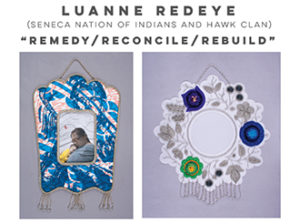
Sept. 7, 2018 – “ᎠᏍᎦᏯ ᎦᏅᎯᏓ (Long Men): the native streams and rivers of the land” by Joseph Erb (Cherokee)
Joseph Erb (Cherokee) is a computer animator, film producer, educator, language technologist and artist. Erb described his work in his artist statement: “The purpose of my research and creative production is to advance the Cherokee culture and language. Social justice and activism is the base philosophy of my interdisciplinary work. Indigenous people face some of the worst disparities in the country in education, health and environmental safety. Art, music and cultural expression have always been positive ways that Indigenous people have persevered. However, Indigenous art has been stereotyped, commodified, and at times stolen from the first communities in which they were born. I believe my role is to provide creative venues for my community members to take back ownership of their stories and express them in ways that are meaningful to them. This includes sharing stories in new ways so that children and grandchildren can have access to them in the future.”
Erb holds a BFA from Oklahoma City University and an MFA from the University of Pennsylvania. He is an assistant professor in the Digital Storytelling Program and Department of Art at the University of Missouri. He works in the fields of 2-D and 3-D animation; digital storytelling; fine art — painting, metal and textiles; Native American and Indigenous studies; Cherokee language technology and Cherokee studies.
Erb’s exhibition explored themes concerning the intersection between culture and water and celebrating the stories and struggles of the water, and it featured three sets of sculptural works, hung or mounted, and digital animation shown in three short movies. The movies lasted from 4 minutes to 8 minutes, and two featured Cherokee language with English subtitles. Learn more on his website and Instagram.
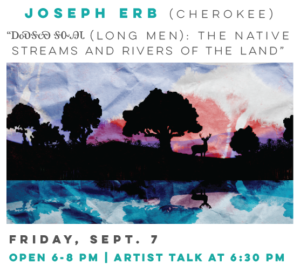
Aug. 3, 2018 – “A Fanciful Escapade” by Gina Herrera (Pueblo of Tesuque)
Gina Herrera (Pueblo of Tesuque) was raised in Chicago and currently resides in California. In her artist statement, Herrera said: “While my heritage incorporates the Tesuque Pueblo and Costa Rica, my strongest affinity is to nature. While serving in Iraq, amid the devastation of combat, my visceral reaction to miles of mountainous trash heaps, the evidence of systematic yet unconscious destruction of our planet led me to question my own practices. I began to build assemblages out of discarded and natural objects. I am engaged in an aesthetic and spiritual ritual to channel and honor Mother Earth. I constantly gather materials, finding inspiration in my surroundings. Like a scavenger, I play an interventional role in removing garbage from the landscape, preventing further damage. I am also drawn to natural materials and organic forms. My process is meditative and intuitive. Figures emerge, in gravity defying poses on the brink of movement, alive with possibility. Their haunting spiritual presence reminds us they have not gone back to the earth but asks us to question the choices we make in our daily existence.”
For Travois First Fridays, Herrera’s exhibition featured large sculptural works.
Herrera holds a BFA in art education from the School of the Art Institute of Chicago. While she was a student, she was deployed overseas in support of several war contingencies with the United States Army. Once her final tour was complete, she obtained her MFA from the University of the Arts in Philadelphia. As a graduate student, she was awarded a Provost Fellowship, an MFA scholarship and was nominated for the Joan Mitchell Foundation MFA Grant Program in 2012. Herrera received a full Native American Residency Fellowship from the Harpo Foundation to attend the Vermont Studio Center in 2013. Herrera has exhibited extensively in California and nationally and has received awards: she is a six-time ArtSlant Prize Showcase Winner, she received a Merit Award from Art Kudos and received an Award of Excellence from Manhattan Arts International.
Herrera’s dedication to service extends to all aspects of her professional life – from her 20+ years in the military to educating and inspiring the next generation as an art teacher at Arvin High School and as an adjunct professor at Bakersfield College. Learn more on her website, Facebook and LinkedIn.
June 1, 2018 – “Life Is Breathtaking” by Cannupa Hanska Luger (Mandan, Hidatsa, Arikara, Lakota)
Born in North Dakota on the Standing Rock Reservation, multidisciplinary artist Cannupa Hanska Luger comes from Mandan, Hidatsa, Arikara, Lakota, Austrian, and Norwegian descent. His artist statement explains that his “work communicates stories of complex Indigenous identities coming up against 21st century challenges, including human alienation from and destruction of the land to which we all belong.” Luger “provokes diverse publics to engage with Indigenous peoples and values apart from the lens of colonial social structuring.”
Luger’s practice combines critical cultural analysis with dedication and respect for the diverse materials, environments and communities he engages. He is known for his ceramic innovations, interpreting the material with patience and experimentation. He also tells stories using fiber, steel, cut-paper, video, sound, performance, monumental sculpture, land art installation, and social collaboration. Luger holds a BFA in studio arts from the Institute of American Indian Arts. He was a recipient of the 2016 Native Arts & Cultures Foundation National Artist Fellowship Award and has participated in artist residencies and institution lectures throughout the nation. He maintains a studio practice in New Mexico. His work is collected and exhibited internationally.
For Travois First Fridays, Luger exhibited various groupings of ceramic and mixed media sculptural works including “Life Is Breathtaking,” a series of ceramic buffalo skulls informing the exhibition’s title and which represent various stages of commodification and perceived value. For all of the various artwork series presented, Luger uses materials that are emblematic of human civilization such as clay, textiles and steel to communicate our current collective experience and challenge systemic conditions such as capitalism.” Learn more on his website, Facebook and Instagram.
May 4, 2018 – “Rituals” by Porfirio Gutiérrez (Zapotec)
Porfirio Gutiérrez is a proud descendant of many generations of Zapotec weavers from Teotitlán del Valle in Oaxaca, Mexico. In his artist statement, Gutiérrez detailed his background: For over 2000 years, this town has been a wellspring of Zapotec textile arts and culture. Gutiérrez’s father, who was a master weaver, saw his potential and took every opportunity to help him develop and refine his artistic skills as a weaver. As Porfirio’s talent grew, his appreciation for his Zapotec heritage and traditional arts deepened, and his personal expression has been influenced by stories told by his elders about cultural rituals, ceremonies and the Zapotec way of life in the past.
When Gutiérrez eventually settled in California, the artistic roots that were deep set in Oaxaca soon expanded to include influences from life in urban America. His work has now been shown in eight countries on four continents. The story of his art has been told in publications such as the New York Times and videos televised on PBS, Univision, as well as a documentary funded by the Smithsonian Institute’s NMAI. In 2015, Gutiérrez was chosen by the Smithsonian Institute to be one of only four artists in the Western hemisphere to participate in their prestigious Artist In Leadership Program. Gutiérrez continues to be a tireless advocate, educator and ethnic ambassador for traditional Zapotec arts and culture.
Learn more on his website and Facebook page.
Related articles:
Travois First Fridays: “Rituals” by Porfirio Gutiérrez
March 2, 2018 – “Domiciles” by Chris T. Cornelius (Oneida Nation of Wisconsin)
Chris T. Cornelius, a citizen of the Oneida Nation of Wisconsin, is an associate professor of architecture at the University of Wisconsin-Milwaukee who focuses his research and practice on the architectural translation of culture; in particular, American Indian culture. He is the founding principal of studio:indigenous, a design and consulting practice serving American Indian clients.
In his artist statement, Cornelius said the work in this exhibition “examines the nineteen-month American Indian occupation of Alcatraz Island from November 20, 1969 to June 11, 1971. The occupiers took the island through by asking the U.S. Government to honor a treaty they had made 100 years prior. They did not want the island for financial or political gain; they wanted it to create an American Indian cultural center that included American Indian Studies, and American Indian spiritual center, an ecology center and an American Indian Museum. My work supposes, ‘What if they got what they wanted?’ and I will be designing the results.”
Visit his website at www.studioindigenous.com, Facebook page at www.facebook.com/StudioIndigenous and on Instagram @christcornelius.
Pictured above from left to right:
“Radio Free Alcatraz: Territories,” 2014, Graphite, colored lead, applique film on Mylar, 18 x 24 inches.
Bear, 2009, Sculpture from copper mesh, brass, bronze, Hydrocal, cigar box, 20 x 25 x 8.5 inches.
“Domicile 03: New Year Moon,” 2011, Watercolor, graphite, colored lead, gouache, toner transfer, 8.2 x 10.1 inches.
Related articles:
Travois First Fridays: “Domiciles” by Chris T. Cornelius
Dec. 1, 2017 – Travois Design and JT Daniels
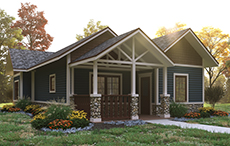
Drawings and structural models were on display to demonstrate how affordable homes in Indian Country can be green, beautiful and culturally relevant. The talented team of architects that make up Travois Design, led by Ashley Bland, are devoted to strong listening and engagement. This artistic team works closely with American Indian, Alaska Native and Native Hawaiian partners through community charrettes to inform the design and development of homes, community centers, health clinics and government buildings that will serve generations to come. The Travois Design team includes Lauren DuCharme, Adam Teefey, Taylor Higgins, Jason Betts, Zach Higgins, Elsa Garcia and Shani King.
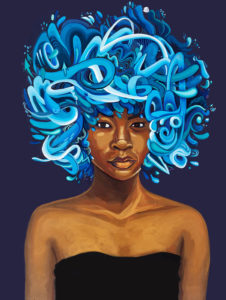
JT Daniels’ work is inspired by the story lines of people he’s talked to and shared spaces with. He is described as one of the most exciting emerging Kansas Citians. He works with youth and community-driven art programs to reflect emotion in design and display Kansas City’s stories, history and people in everyday public life.
Related articles:
Travois First Fridays: Community Inspired Design
Nov. 3, 2017 – Maura Garcia
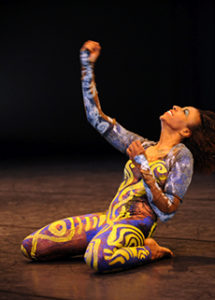
Maura Garcia is a dancer and choreographer who collaborates within communities to create stories of identity and place. Originally from North Carolina, Maura is an indigenous woman (non-enrolled Cherokee/Mattamuskeet) who uses her art to form connections, uplift indigenous cultural values and explore the rhythms of the natural world. She collaborates to create multimedia, interactive shows and experiential workshops involving audiences.
Maura presented an interactive artist talk and performance at the Nov. Travois First Friday event.
Related articles:
Q&A with dancer and choreographer Maura Garcia
Oct. 6, 2017 – Matika Wilbur
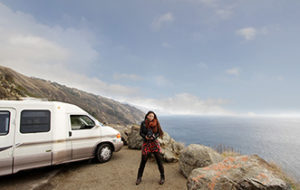
Matika Wilbur, a Native American woman of the Swinomish and Tulalip Tribes, is a photographer and social documentarian. She is currently working on Project 562, a national documentary project dedicated to changing the way we see Native Americans through authentic images and real narratives from contemporary Native America.
Her “Seeds of Culture: The Portraits and Stories of Native American Women” exhibition was on view during October. Matika gave a powerful talk titled “Changing the Way We See Native America: Dismantling Native American Stereotypes.”
Related articles:
Matika Wilbur to kick off Travois First Fridays exhibition series
Sept. 1, 2017 – Anthony Oropeza
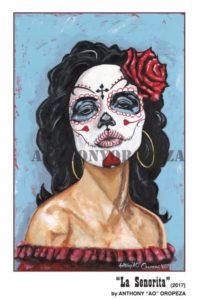
Anthony Oropeza is a Kansas City artist and designer who creates and produces sports paintings, fine and cultural art, comic book art and character art through his art and design studios: AOART5 and Strong Ave. Studios. He is also a writer, producer, publisher and creator of a bilingual comic book created for kids to promote reading (AMIGOMAN™). His comic book publication allows him to visit area schools to speak to students about what he does as an artist in creating, designing, writing and publishing his work.


